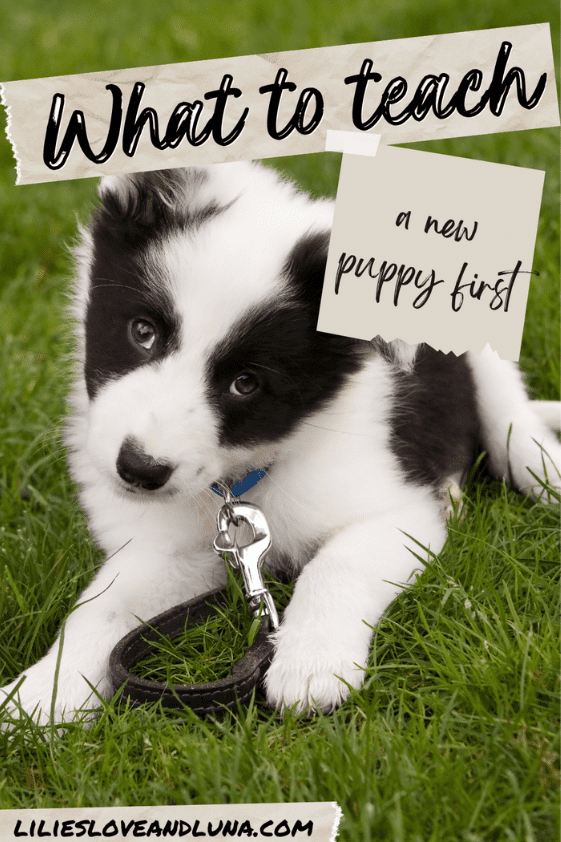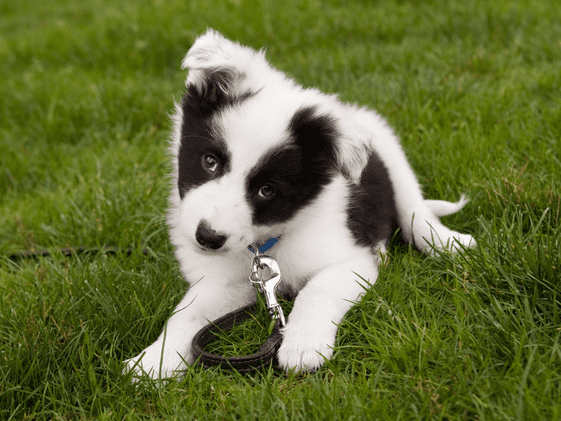Congratulations on bringing home your new puppy!
This is an exciting time, but it’s also an important time to start training your new dog. It takes time to train your puppy to be a well-behaved dog, so the sooner you start, the better.
Here are ten things you should begin teaching your puppy from the moment you bring them home.
This post may contain affiliate links. That means if you click on them and buy something, I may receive a small commission at no cost to you. Read my Disclaimer Policy to learn more.
When should I train my puppy?
Training should start the day you bring your puppy home and should continue throughout their life. Even an adult dog can benefit from daily training sessions.
You should plan on at least 15 to 30 minutes of training daily. This can be done in several short sessions throughout the day, or, for older dogs, in one longer session.
Just try to get in a total of 15 to 30 minutes of training daily.
How do I train my puppy?
There are many different ways to train your puppy. You can sign up for a puppy training class, hire a professional dog trainer, or read books and online articles (like this one!).
The most important thing is to be consistent in your methods and to use positive reinforcement training. This gives your puppy a positive association between the words you say and the behavior they do.
It’s also important to start with simple commands before moving to more complicated things.
What are the first things I should teach my puppy?
There are 10 things you should start training your puppy. This may seem like a lot, but many of them can be done one at a time.
Start with teaching them their name and working on potty training, and crate training. After a day or two of just those, start adding in some basic commands, like “sit”.
From there, follow your puppy’s lead. If they get the hang of sit quickly, move on to another skill.
Just remember to continue practicing what you already taught your puppy to reinforce the behavior.
Teach your puppy their name
The first thing you should do when you bring your puppy home is to teach them their name.
This may seem like a no-brainer, but it’s important for your puppy to understand and respond to their name.
The best way to do this is to say their name often throughout the day in different tones and with different inflections.
You can also use their name when you give them treats or pet them.
Eventually, your puppy will associate their name with something positive and they’ll start to respond to it.
House training

House training is one of the most important things you can do for your puppy. While potty training pads can be helpful, it’s ultimately best to teach your puppy to go outside, that way, there won’t be any accidents when you’re not home to supervise them.
Start by taking them out frequently for potty breaks, after every meal, nap, and play session. Immediately praise them and give them a treat when they go potty in their potty spot.
Eventually, he’ll learn that going outside is what gets him those yummy treats!
House training does take time. No puppy will get this immediately and it’s common for a potty accident to happen at least once or twice. Check out this post for more potty training information.
Crate training

Crate training is a great way to aid in potty training your puppy. It’s also a great way to provide them with a safe place to stay when you’re away from home.
It’s important to begin crate training early so that your puppy doesn’t develop negative associations with his crate later on. Start by placing his food bowl just inside the crate so that he has to go inside in order to eat.
Once he’s comfortable eating inside the crate, you can begin closing the door for short periods of time while you’re still home.
Crate training takes time and patience. This post has more crate training information.
Look at me

Teaching your puppy to look at you is a great way to get their attention and make them focus on you.
This can be helpful when you’re teaching other commands or if you need to get their attention in a distracting environment.
To teach your puppy to look at you, hold a treat close to your face and say their name.
When they look at you, give them the treat and praise them.
Do this often throughout the day until your puppy is consistently looking at you when you say their name.
Sit
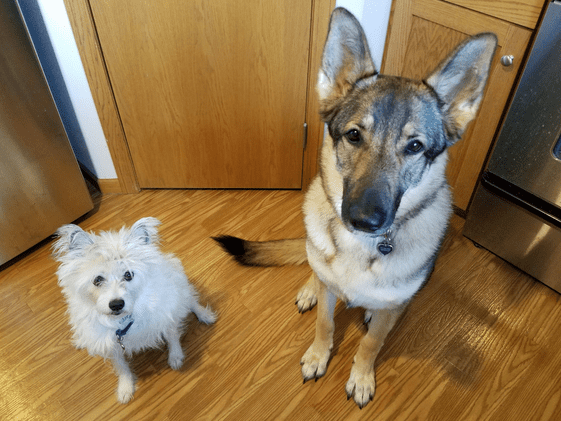
“Sit” is one of the easiest commands to teach your puppy. And it can come in handy in all sorts of situations (like when company comes over or you’re trying to take a picture and he won’t stop wiggling!).
To teach your puppy to “sit,” hold a treat close to their nose and guide it up over their head until they naturally sit down. Then give them the treat and tons of praise!
Continue with leading them with the treat several times, then start adding in the command, “sit.”
As your puppy gets the hang of what you want them to do, you can stop leading them with the treat.
Down
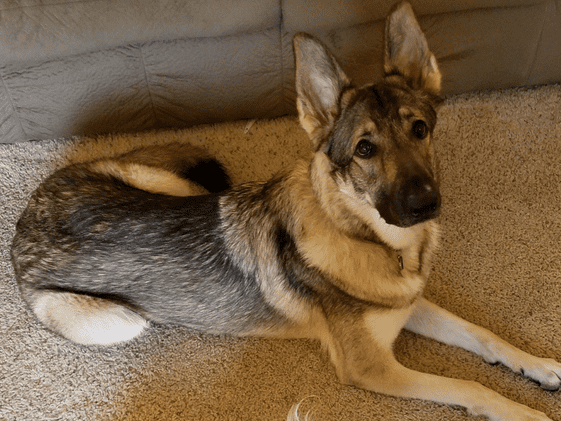
“Down” is another great command that can come in handy in a variety of situations.
To teach your puppy to “down,” start by having him “sit.” Then, hold a treat close to his nose and slowly lower it to the ground while saying “down.”
As he lowers his body to the ground to follow the treat, give him the treat and praise him.
Continue practicing this until your puppy is consistently lying down when you give the command.
Stay
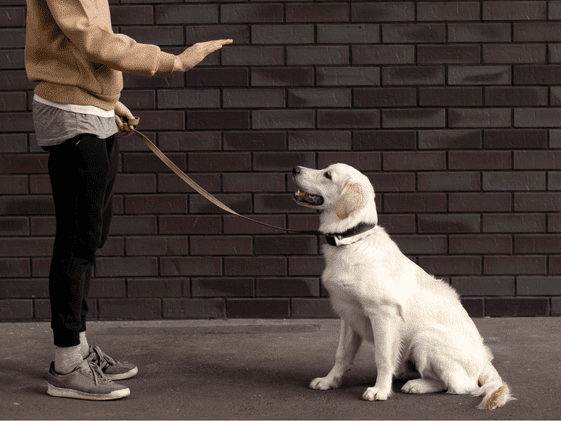
“Stay” is a great command to teach your puppy for both safety reasons and convenience.
To teach your puppy to “stay,” start by having them “sit.” Then, hold your hand out in front of them and say “stay.”
If they stay in the sitting position, give them a treat and praise them.
If they gets up, simply say “oops” and start over.
Continue practicing this until your puppy is consistently staying in the sitting (or lying down) position when you give the command.
Make sure to start with very short periods of time between giving the command to stay and giving your puppy the treat. Gradually increase the time as your puppy is successful with the shorter amounts of time.
Leave it
“Leave it” is a necessary command to teach your puppy for safety reasons. Puppies are naturally curious and will go after anything on the floor.
If they know “leave it” and you drop something they shouldn’t have, it gives you time to pick the item back up. This prevents them from eating something that could make them sick, or worse.
To teach your puppy to “leave it,” start by holding a treat in your hand and saying “leave it.”
If your puppy tries to take the treat, close your fist around it.
Once they stop trying to take the treat, say “good dog” and give them a different treat from your other hand.
Repeat this process until your puppy is consistently leaving the treat in your hand when you say “leave it.”
Come when called
“Come” is an important command for your puppy to know for safety reasons. If they get loose outside, come should get them to come back to you.
To teach your puppy to “come,” start by having two people at opposite ends of a hallway with your puppy in the middle.
One person should say the puppy’s name and encourage them to come. Once the puppy gets there, they should reward them with a treat and praise. Then the other person does the same.
Once the puppy is reliably going to each person add in the command “come” after saying their name. Also, cut back on the encouragement as they come to you. But make sure to make a big deal when they get to you.
Once your puppy is reliably listening to “come” in the hallway, gradually increase the distance.
Walk on a Leash
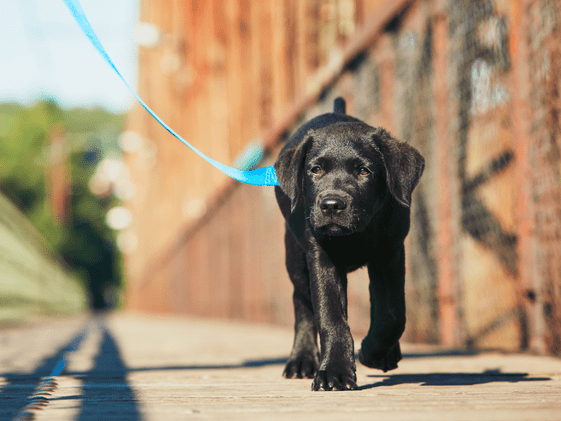
Walking properly on a leash is a very important skill to teach your puppy. It prevents them from injuring themselves or you. It also makes the walk much more enjoyable for both of you.
To teach loose leash walking, start by getting your puppy used to the leash. Do this by attaching it to their collar or harness and letting them get used to how it feels.
Then, pick up the leash and hold it for a bit. This gets them used to how it will feel when you are walking.
Once your puppy is used to the leash, walk around the house a little as you would outside. Praise them and give them treats when they walk calmly with you.
Once your puppy can walk on the leash inside, it’s time to take them outside. Start slowly, and focus on keeping the leash loose.
And most importantly, remember to be patient! Puppies have short attention spans and will need plenty of practice before they get the hang of it!
Puppy socialization skills

Socialization is critical for puppies. It helps them grow into well-adjusted dogs that are comfortable around people and other animals.
The best time to socialize your puppy is at a young age. The best time is between 8 and 16 weeks of age, but that isn’t always possible. No matter what age your puppy is, getting them socialized is the important thing.
Some great ways to socialize your puppy are:
- Take them to puppy socialization classes (these are great for young puppies as all attendees are about the same age).
- Take them on walks in different places, like around the block, in a park, etc.
- Invite friends over to your house. This is a great way for your puppy to meet new people.
- Take them to the dog park. Just remember not all dog owners have taught their dogs good manners and be ready to leave if your puppy becomes stressed
Remember, the key to socialization is exposure. The more your puppy is exposed to different people, places, and animals, the better!
One caveat: Talk to your vet about safe places to take your puppy for socialization before they have had all their shots.
Depending on where you live, even walking your puppy around the neighborhood can be a risk. Your vet will know what is safe for your area.
Puppy biting
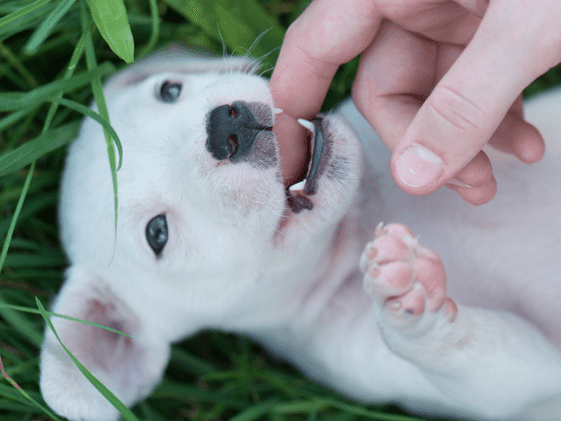
Teaching your puppy not to bite is one of the most important things to teach them early, especially if you have young kids. Puppies have sharp teeth, and even an accidental bite can hurt.
One way to stop your puppy from biting is to offer them a chew toy. Every time they start to bite you, say “no” and give them the toy. Also, leaving chew toys out all day gives your puppy the option of using them whenever they want or need to.
Another way to stop your puppy from biting is to yelp when they do it. This simulates how another dog would react and usually gets their attention.
Once they stop biting, praise them and give them a chew toy.
Remember, it’s important to be consistent with your puppy. If you let them get away with biting sometimes, they will think it’s okay. So be sure to always yelp or offer the chew toy when they start to bite.
Bonus: shake hands!

One of the cutest things you can teach your puppy is how to shake hands. It’s a great way to show off their tricks and impress your friends!
To teach your puppy how to shake hands, start by having them sit. Once they are in a sit, show them a treat and close your had around it.
Put your hand, palm side up, in front of your puppy at chest level. Your puppy should paw your hand to get the treat.
As soon as they paw at your hand, open it and give them the treat.
Repeat several times, then remove the treat from that hand. When your puppy paws your empty hand, give them a treat from the other hand.
Once your puppy has the hang of this, start adding the command “shake hands” or something similar.
With enough practice, your puppy will learn how to shake hands on command!
Basic Puppy Training Tips
Patience. Patience. Patience. Puppy training takes a lot of patience. Puppies are young. They are impulsive and have short attention spans. It will take time. Remember that it’s not a race, your puppy will learn, but it will take time.
Be consistent. Use the same words for each command every time. If you choose to say “come” to teach come to me, use it every time. Don’t alternate between “come” and “here.” And everyone should use the same words. Changing the words will confuse your puppy.
Start early. The sooner you start training your puppy, the better!
Use positive reinforcement. Dogs respond best to positive reinforcement, so be sure to praise your puppy and give them a treat when they do something good.
Listen to your puppy. If your puppy isn’t into a training session, try again later. Or use a different reward. Different dogs like different things. Some love a tasty treat as a reward. Others prefer to have playtime. And still others are happy with just getting some positive attention.
Find what works for your puppy and use that.
Final Thoughts
It’s never too early to start training your puppy! In this article, we have outlined several things to start teaching your puppy. These include teaching your puppy how to walk on a leash, crate train, house train, and follow the command ‘sit.’
Remember to be patient with your puppy and use positive reinforcement when they do something good.
Puppy training takes time and patience, but it is well worth the effort in the end!
Related Posts
How To Make Your Home Safe For A New Puppy
The Ultimate Guide To What You Need For A New Puppy
How To Survive The First 48 Hours With A New Puppy
